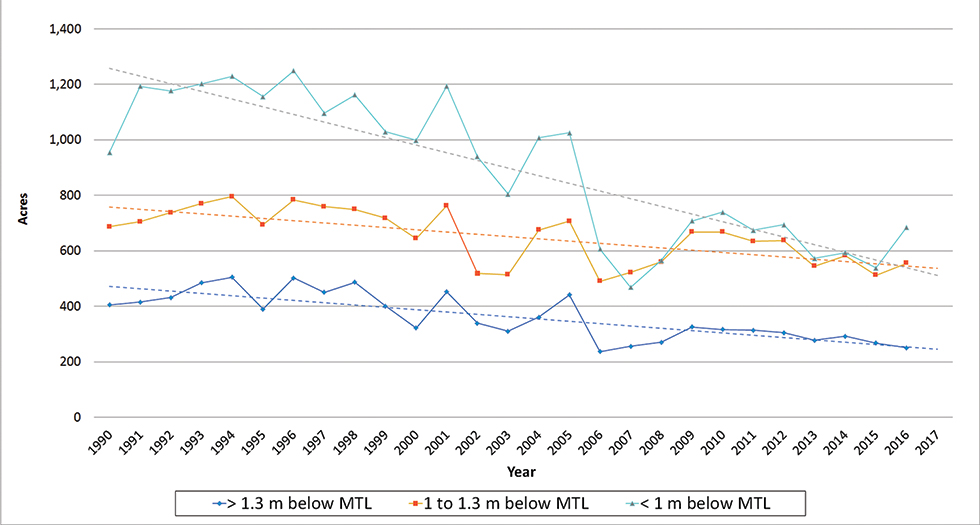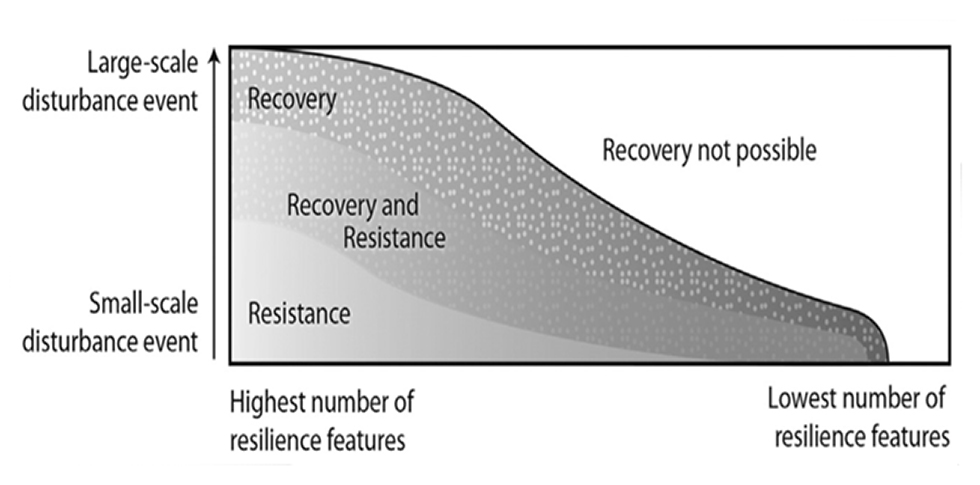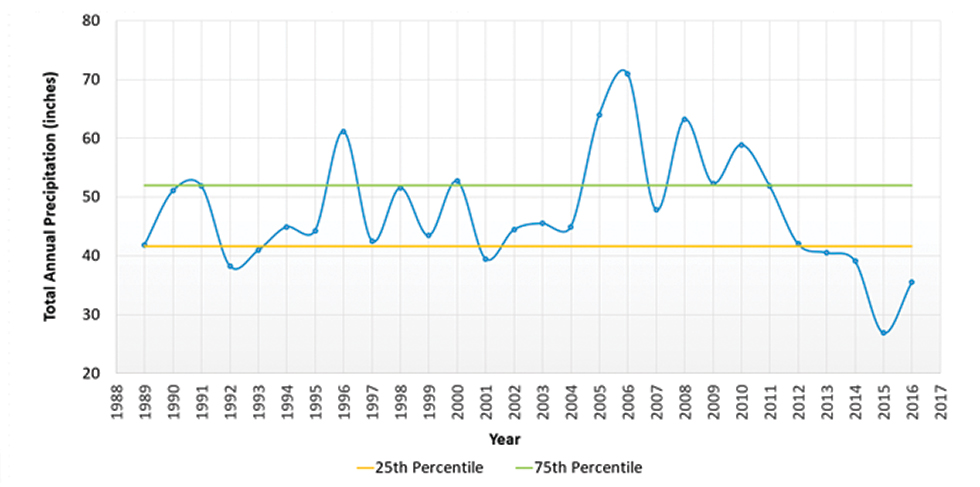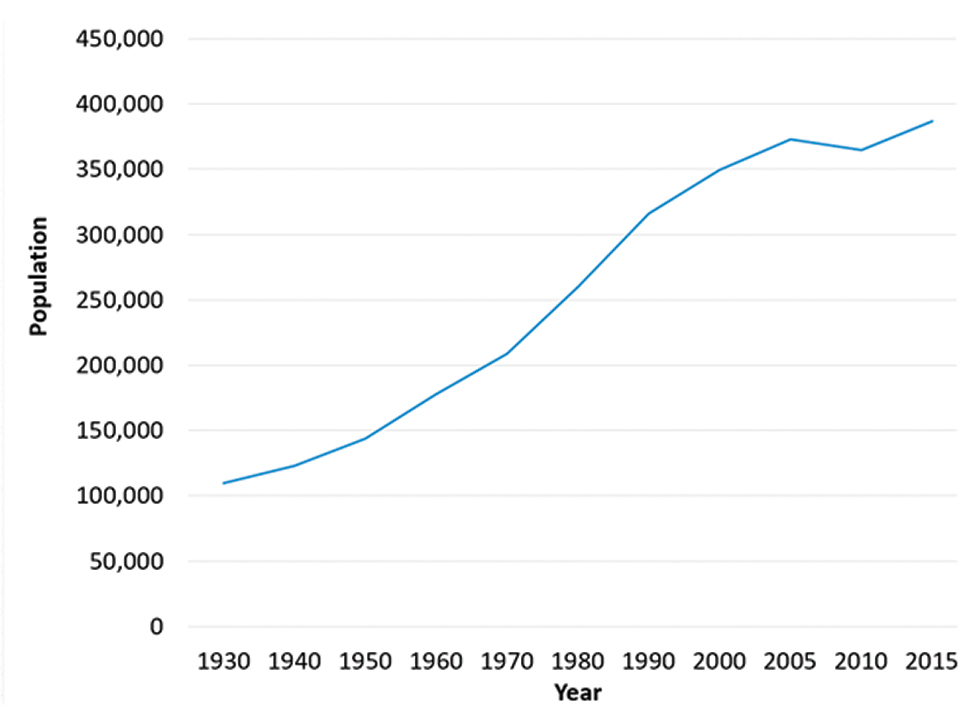THE BIG PICTURE
GIVEN THAT OUR GOAL IS HEALTHY ESTUARIES, WE SHOULD CONSIDER TAKING ACTION TO IMPROVE THE OVERALL RESILIENCE OF THESE SYSTEMS.
PREP is one of many groups that work to protect and restore the estuaries in the Piscataqua Region. In our collective pursuit to understand what is driving the declining health of our estuaries, the debate has often centered on a single dynamic—the relationship between nitrogen and eelgrass loss. Nitrogen is an important factor that cannot be dismissed, but it is only one of many shocks and disturbances that impact our estuaries.2 Some of these are slow-acting and chronic, others are episodic. Some are within our control, others much less so. All of these influences, however, act as stressors on estuarine health, and cannot be considered independently of one another. Some of the most significant include the following:
Building Estuary Resilience in a Time of Change
There are many more stressors on estuarine health that need consideration, but we lack the data to track. These include disturbance by geese, green crabs, and other animals, and the cascading effects that come from the loss of large predatory fish, invasive species, and disease. It is critical to understand that all stressors—from extreme precipitation to disease—are additive and synergistic. Combined, they change each other’s impacts in ways that make it very difficult to isolate the relationship between any one factor and a biological response.
In the case of oysters, it is acknowledged that disease (MSX and Dermo) has been the primary source of their deterioration. Resource managers locally—as well as in other parts of the world10—have recognized that we cannot limit our management actions to one primary stressor. However, we can help oysters become more resilient through restoration, providing more available substrate (shells) on which larvae can settle, or conducting oyster restoration in a way that encourages more vertical growth to help the oysters avoid being smothered by sediment.
In the Great Bay Estuary, eelgrass loss over time has been most pronounced in the deepest beds,11 suggesting that lack of light is contributing to its decline (Figure 3). CDOM, TSS, and phytoplankton all combine to decrease water clarity and reduce the light that is available to eelgrass. In addition, precipitation and development influence the impact of all of these constituents on the health of our estuaries.

Figure 3 Acres of Eelgrass in Particular Depth Regimes in Great Bay. New Hampshire Department of Environmental Services analysis of loss of eelgrass by depth in Great Bay only. MTL = mean tide.
Some stakeholders tend to analyze these light-attenuating components separately, asking which of the three is the stressor on eelgrass. To help eelgrass recover, however, we cannot focus our management strategies on reducing the one factor that limits light the most as these stressors impact the system in an additive way;12 a more comprehensive approach will be required.
It is also important to consider how eelgrass, seaweed, and phytoplankton compete for light and nutrients. Algae do not have roots like eelgrass and so they are dependent on nutrients in the water column. When algae are not limited by nutrients, as was indicated in a study of the green seaweed Ulva in 2010,13 providing more light by reducing TSS or CDOM may not help eelgrass and instead lead to increases in seaweed and phytoplankton.
Given that our goal is healthy estuaries, we should consider taking actions to improve the overall resilience (Figure 4) of these systems. We may have little control over episodic events like extreme storms, but we can reduce the short-term and chronic impacts of these events by continuing to improve stormwater practices, conserve land, and better manage the buffer lands along the edges of our rivers, bays, and coast.14

Figure 4 Resilience in Response to Disturbances. Resilience is comprised of resistance (light grey shade) and recovery (spotted fill) processes. Habitats with the highest number of resilience features (x axis) can resist and/or recover from large-scale disturbance events. As the number of resilience features declines, so does the capacity of the habitat to resist or recover from such disturbances.16
We also can continue to work together to reduce nitrogen loading to increase resilience. The external reviewers (engaged by PREP’s Technical Advisory Committee to analyze eelgrass stressors for the Great Bay Estuary) have indicated we should build on the significant reductions from municipal wastewater sources and focus on reducing non-point source (NPS) nitrogen, which accounts for 68% of the nitrogen load. (For a synthesis of this external expert review,15 see below).Resilience: The capacity of an ecosystem to absorb repeated disturbances or shocks & adapt to change without continually degrading & fundamentally switching to an alternative stable state.1
As we work together on solutions, it is important that we recognize that the path back to healthy estuaries may not be the reverse of how we got here. Our estuarine resources and their stressors are different than they were 30 years ago. The impacts we have experienced are significant and recovery may be slow and unpredictable.17 In light of this, we need to be prepared to invest in data collection and analysis that will allow us to better understand the impacts of the many stressors influencing the health of our estuaries, track the impacts of past management actions, and modify future strategies so they are as effective as possible.
EXTERNAL ADVISOR REVIEW OF STRESSORS IN GREAT BAY
In 2016 and 2017, external advisors were asked to provide input on which stressors to prioritize when managing for improved ecosystem health, with an emphasis on eelgrass. Using 44 different sources of information on the ecology of the Great Bay and Hampton-Seabrook estuaries, the external advisors made the following observations:
- Eelgrass continues to recover partially, but it has not returned to its previous abundance. While returning to historic conditions may be possible, it will be challenging and it may require stressors to decrease to levels that are lower than those observed before eelgrass began to decline.
- Narrowly focusing on single stressors does not reflect the complexity of our estuarine systems.
- Despite encouraging reductions from wastewater treatment facilities, nitrogen loading levels are high enough that they should be considered an important stressor.
- To decide how much nitrogen reduction is enough, a thorough, quantitative ecosystem based model would be required.
- Based on available information, it is evident that a large fraction of the nitrogen entering the system comes from non-point sources. Given that only 2.6% of its watershed is occupied by wetlands, which buffer non-point sources of pollution, the Great Bay Estuary is extremely vulnerable to nonpoint source loadings.
- Eelgrass decline may relate to episodic stressors, such as storms, but it is equally plausible that chronic stressors, such as decreased water quality, may have limited the resilience of eelgrass to episodic disturbances. More comprehensive data is needed to better understand the interactive effects of these stressors.
Click here to read the complete external advisor report.

